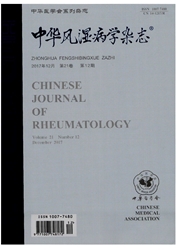

 中文摘要:
中文摘要:
目的探讨中国汉族男性人群巨噬细胞移动抑制因子(MIF)启动子区-173G/C(rs755622)基因多态性的分布与原发性痛风遗传易感性之间的关系。方法选取380例痛风患者和378名健康对照者,采用聚合酶链反应.序列特异性引物(PCR-SSP)技术,检测中国汉族男性人群中MIF启动子区-173G/C基因等位基因及基因型频率的遗传分布,HaMy-Weinberg检验确认标本的群体代表性后,采用χ2检验进行关联分析,采用t检验对MIF基因-173G/C位点基因多态性与痛风危险因素进行比较。结果痛风组MIF启动子区-173位点GG、GC、CC基因型的频率为62.1%(236个)、34.2%(130个)、3.7%(14个);健康对照组MIF启动子区-173位点GG、GC、CC基因型频率为66.5%(252个)、29.8%(113个)、3.7%(14个),2组之间比较差异无统计学意义(χ2=1.713,P=0.425)。痛风组等位基因G、C的频率分别为79.2%(602个)和20.8%(158个),健康对照组为81.4%(617个)和18.6%(141个),2组之间等位基因G、C频率的比较差异也无统计学意义(χ2=1.148,P=0.302)。将痛风组基因型分析为GG基因型与Gc基因型合并为GG±GC组,结果显示:GG±GC组与CC组之间年龄[(51±13)和(50±15)岁,t=0.369,P=0.712]、血糖[(7.1±8.8)和(6.1±1.2)mmol/L,t=0.352,P=0.725]、甘油三酯[(2.3±1.6)和(2.9±3.4)mmol/L,t=-1.207,P=0.228]、胆固醇[(5.3±1.2)和(5.7±1.4)mmol/L,t=-1.207,P=0.228]、尿素氮[(5.8±2.9)和(6.2±2.2)mmol/L,t=0.513,P=0.608]、肌酐[(92±52)和(84±17)μmol/L,t=0.537,P=0.592]、尿酸[(472±103)和(557±154)μmol/IJ,t=-2.949,P=0.03]比较差异均无统计学意义(均P〉0.05)、经t检验,MIF基因-173G/C基因多态性位点与痛风病危险因素之间无相关性(乃0.05o结论
 英文摘要:
英文摘要:
Objective To explore gene polymorphism of the G/C genotype of -173G/C (rs755622) in the promoter of macrophage migration inhibitory factor (MIF) gene in male population, and thus to investigate the relationship between gene polymorphism of MIF and gout. Methods A total of 380 gout patients and 378 healthy controls were enrolled. The possible assoeiad0n between the polymorphism of MIF -173G/C and gout in Chinese were investigated and genotype frequencies itnd allelic frequencies were analyzed by polymerase chain reaction with sequence-specific primers (PCR-SSP) method. Hardy-Weinberg was used to verify the representativeness of the samples. Comparisons between the groups were performed with X2 test. The gene polymorphism of MIF and gout was performed by t test. Results The frequencies of GG, GC, CC genotypes were 62.1%(236 eases), 34.2%(130 eases) and 3,7%(14 cases), respectively among gout patients, while they were 66.5%(252 cases), 29.8%( 113 cases) and 3.7%( 14 cases), respectively among the controls. There was no statistical difference in MIF -173G/C genotype frequencies between gout patients and controls (χ2= 1.713, P=0.425). The allele frequencies of G and C in gout cases were 79.2%(602 eases) and 20.8%(158 cases), while the controls were 81.4% (617 cases) and 18.6% (141 cases), and no significant difference between them could be found (χ2=-1.148, P=0.302). Combine GG and GC of gout into GG+GC, the association analysis of the two groups showed that, mean age, leves of glucose, TG, TC, BUN, Cr and UA of the GG+GC group and the CC group were (51±13) and (50±15)t=0.369, P=0.712; (7.1±8.8) and (6.1±1.2) mmol/L, t=0.352, P=0.725; (2.3±1.6) and (2.9±3.4) mmol/L,t=-1.207, P=0.228; (5.3±1.2) and (5.7±1.4) mmol/L, t=-1.207, P=0.228; (5.8+2.9) and (6.2±2.2) mmol/L, t=-0.513, P=-0.608; (92±52) and (84±17)μmol/L, t=0.537, P=0.592; (472±103) vs (557±154) μmol/L, t=-2.949, P=0.03 respe
 同期刊论文项目
同期刊论文项目
 同项目期刊论文
同项目期刊论文
 Polymorphisms - 1082 G/A and - 819 C/T in the Interleukin-10 Gene Are Not Associated with Gout Susce
Polymorphisms - 1082 G/A and - 819 C/T in the Interleukin-10 Gene Are Not Associated with Gout Susce Insulin resistance acts as an independent risk factor exacerbating high-purine diet induced renal in
Insulin resistance acts as an independent risk factor exacerbating high-purine diet induced renal in Multiple single nucleotide polymorphisms in the human urate transporter 1 (hURAT1) gene are associat
Multiple single nucleotide polymorphisms in the human urate transporter 1 (hURAT1) gene are associat Dietary and lifestyle changes associated with high prevalence of hyperuricemia and gout in the Shand
Dietary and lifestyle changes associated with high prevalence of hyperuricemia and gout in the Shand 期刊信息
期刊信息
